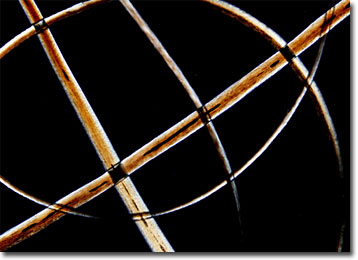Polarized Light Microscopy Digital Image Gallery
Sheep Wool Felt
The wool of sheep, which is primarily composed of the protein keratin, is distinctly wavy, as many as 30 waves being present in a single inch of the natural fiber. This characteristic waviness greatly contributes to the excellent felting ability of wool.

Felting is the process of interlocking wool, hair, or other fibers with certain characteristics together into a consolidated mass through any of a variety of processes, including treatment with heat, moisture, pressure, or agitation. The addition of soap, or the creation of an alkaline environment, may also be utilized to further ease the process of felting. The material that results, commonly known as felt, is non-woven, but the fibers which comprise it can never be returned to their original state because the keratin in the wool or other felting material becomes chemically and irreversibly bound to the protein of the other fibers. Some materials felt much easier than others, depending primarily upon the amount of wave they possess and the scaliness of the fibers. Wool has such a high felting ability that other materials that do not normally felt readily undergo the felting process when wool is added to create a fiber blend.
As a skill, it is generally believed that felting was developed before spinning. Indeed, evidence suggests that sheep wool felts and other varieties of the material were in use thousands of years ago in a number of civilizations around the world. In Siberia, for instance, traces of felt that date back to the fifth century B.C. were found in the tomb of a nomadic tribal chief. Also, various findings indicate that early Roman and Greek soldiers utilized felt for breastplates, tunics, and socks, while common men often wore hats fabricated from the material. Today, hats continue to be one of the most popular items comprised of felt, although the material is also frequently utilized to produce slippers, drapes, apparel, bedding, and rugs, as well as insulation and packing materials.
